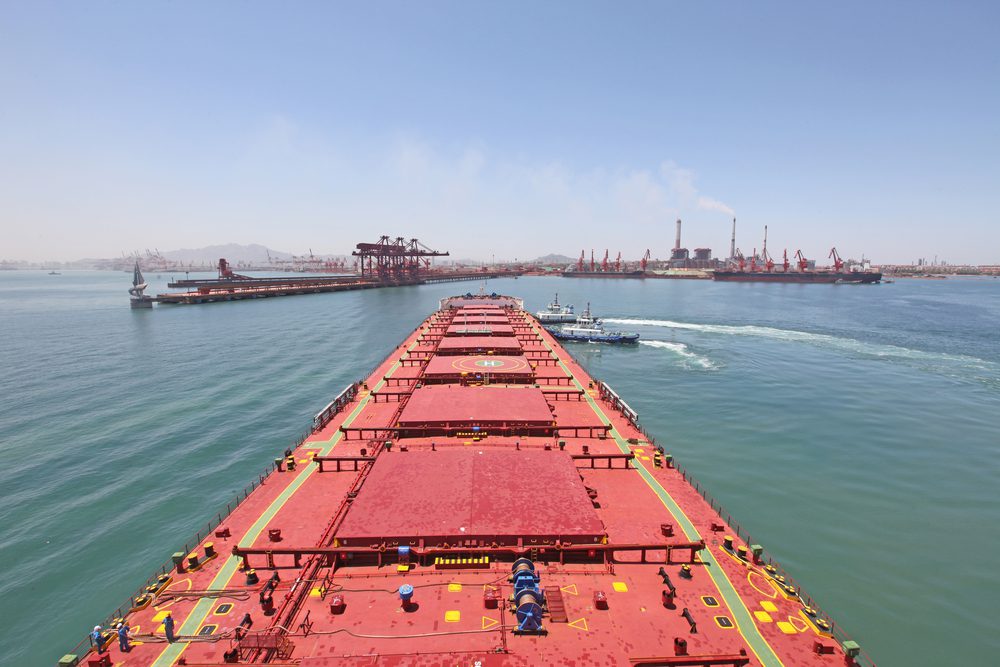Firms in Fed’s Beige Book Fret Over Any Lengthy Baltimore Port Closure
(Bloomberg) — The closure of one of the East Coast’s busiest ports after the collapse of Baltimore’s Francis Scott Key Bridge has so far not led to broad price increases,...


By Naomi Christie
(Bloomberg) — The bear market in iron ore is sending Chinese steel mills on a bargain hunt and giving shipping companies their best rates this year. Analysts and brokers are already warning the good times won’t last.
The acceleration in bookings of Capesizes, 960-foot-long vessels that dominate the ore trade, pushed daily rates to the most since November this month. They are mainly headed to China, which added 3 million metric tons of imported ore to stockpiles at ports in July, the biggest expansion since May 2014.
That replenishment may be short-lived. China’s steel production, the driver of demand for iron ore, will remain flat before declining by the mid-2020s, according to the World Steel Association. Consumption is being eroded by slowing economic growth and a shift toward services from manufacturing.
“I don’t think we’re going to get to sustainably profitable levels probably until at least 2017,” Jonathan Chappell, an analyst with Evercore Partners Inc. in New York, said by phone July 20. “It’s a testament to the slowing Chinese economy, with their steel production contracting.”
Daily Capesize rates rose as high as $14,825 this month, almost three times this year’s average. Returns for the vessels, which can carry about 170,000 tons of ore, are on track to cover running costs for the first time since November. They’re still lower than owners need to break even after finance charges.
Temporary Blip
While China’s iron-ore imports decreased in the first six months from a year earlier for the first time since 1999, that trend may be reversing for now. Stockpiles at Chinese ports have risen to 82.2 million tons, from a 20-month low of 79.35 million tons on June 26.
The rally in freight rates will be “relatively short- lived,” James Leake, the research managing director at Arrow Shipbrokers in London, wrote in an e-mail July 16. “Chinese steelmakers haven’t got deep enough pockets for a prolonged restocking cycle.”
Miners are still shipping ore into a saturated market. Combined exports from Australia and Brazil will increase at least 10 percent in the second half of the year compared with the same period in 2014, Jeffrey Landsberg, head of Commodore Research in New York, wrote in an e-mail July 16.
Output Rises
Brazil, the biggest source of demand for dry-bulk shipping, moved 4.3 million tons more last month than in May, according to government data. Port Hedland, which handles more than half Australia’s iron ore, shipped a record 38.4 million tons in June, according to data from the port authority.
BHP Billiton Ltd., the biggest mining company, said July 21 that its output will rise 6 percent to 247 million tons in its fiscal year ending in June 2016. Iron ore plunged as low as $44.59 a dry metric ton on July 8, the lowest in at least six years. It traded at $52.35 on Monday.
“There is iron ore volume availability to be exported now which we hadn’t seen for the first half of the year to this extent,” Tasos Spiliopoulos, a derivatives broker with London- based Simpson Spence and Young, said by phone July 17 “All the majors are pushing more iron ore out, especially Brazil.”
The voyage from Brazil to China takes about 35 days, or three times the journey from Australia, according to data from Axsmarine.com. The longer ships are at sea, the fewer are available for hire, raising rates.
Rates have also been boosted by owners scrapping more vessels so far this year than in all of 2014. Demolitions may slow as profitability improves.
“It’s more a normalization from an extremely poor situation,” Erik Stavseth, an analyst at Arctic Securities ASA in Oslo said by phone on July 17. “I don’t think rates around $15,000 are going to be there for a sustained period of time.”
©2015 Bloomberg News
Join the gCaptain Club for curated content, insider opinions, and vibrant community discussions.


Join the 105,961 members that receive our newsletter.
Have a news tip? Let us know.
Access exclusive insights, engage in vibrant discussions, and gain perspectives from our CEO.
Sign Up




Maritime and offshore news trusted by our 105,961 members delivered daily straight to your inbox.



Essential news coupled with the finest maritime content sourced from across the globe.
Sign Up